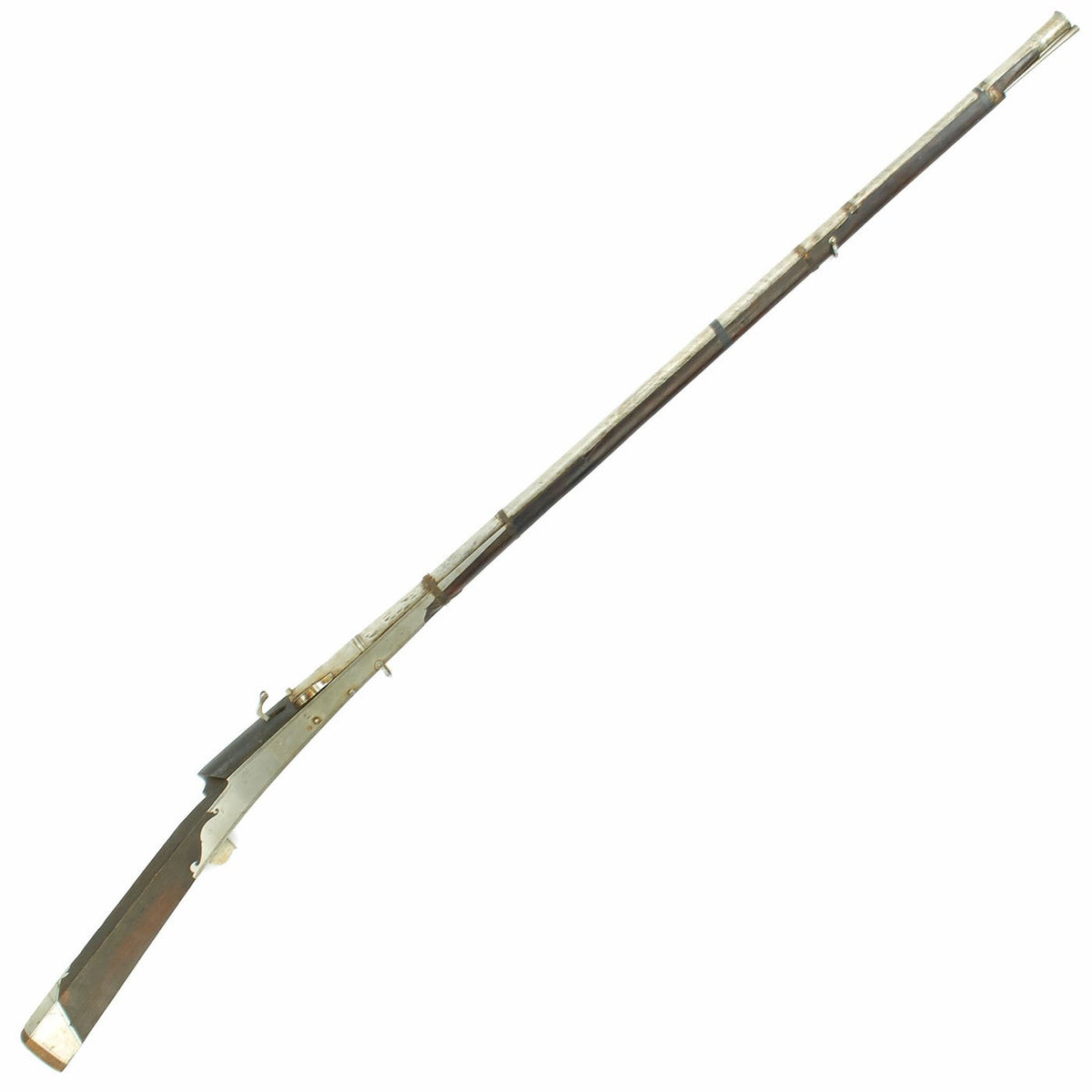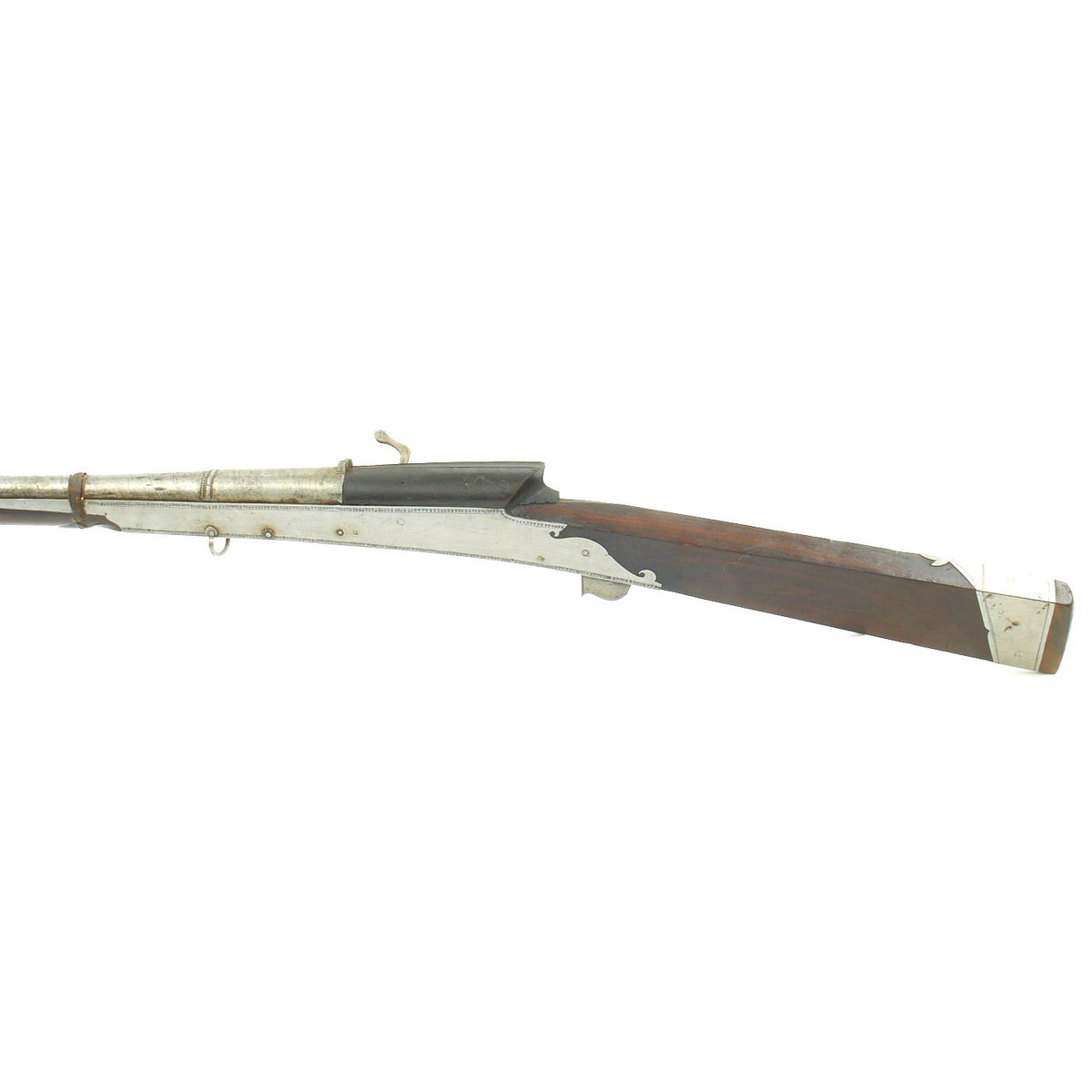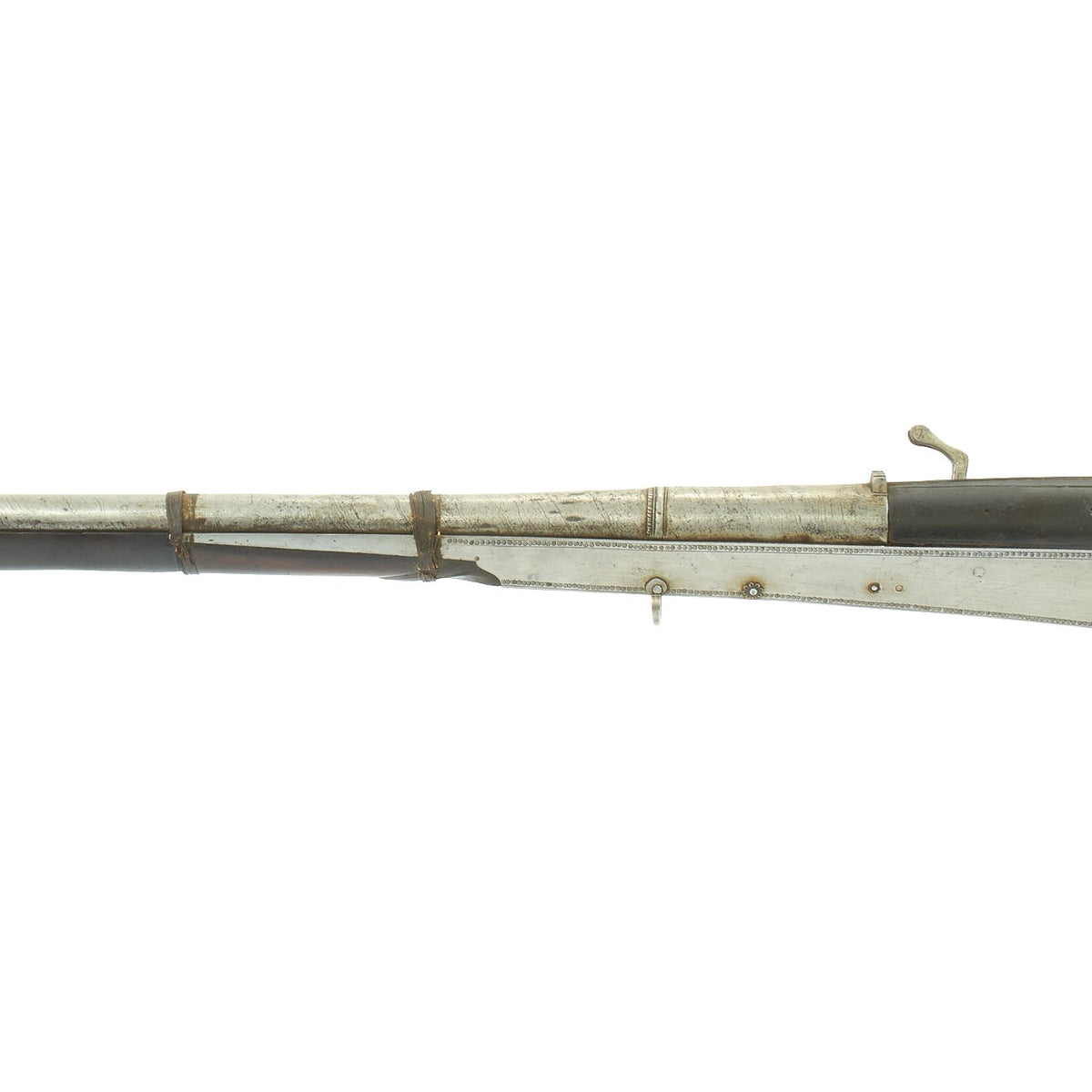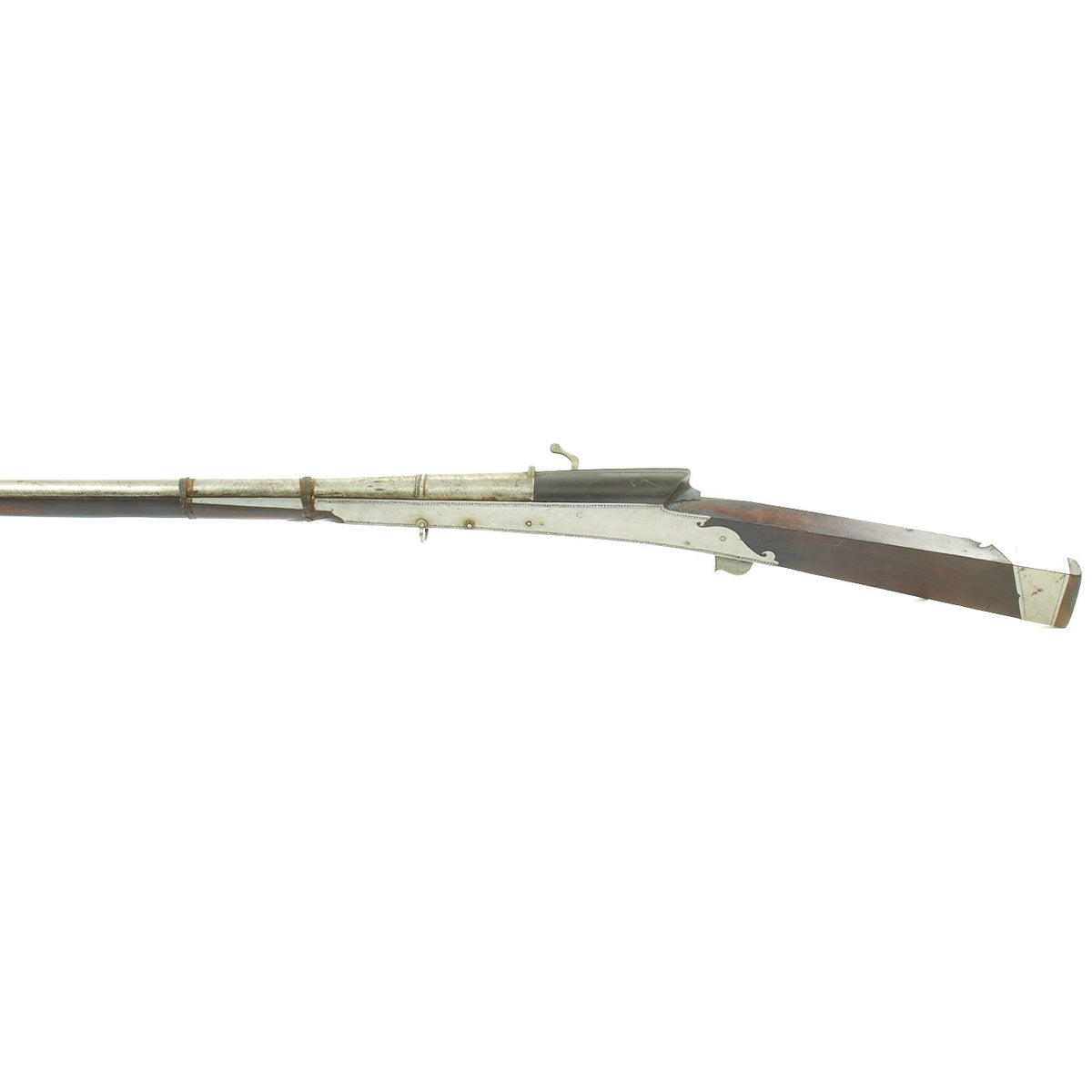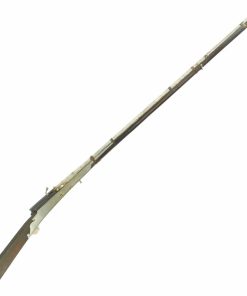Original 18th Century Indian Toradar Matchlock Musket with Damascus Barrel circa 1750 – 64 Inches Long Original Items
$ 1.195,00 $ 298,75
Original Item: Only One Available. This is an elegant Indian Matchlock “TORADAR” gun, measuring 64″ in overall length, the barrel itself being 45 1/2″. The traditional ignition system of the various Indian States of British India, matchlocks were in use on the Sub Continent from the early 1600’s through the 1800s.
With a bore of around .55″, this is a highly maneuverable weapon despite its long length. This example has a slight flare at the muzzle, but we think this to be more for style than anything else. These were always smooth bore, but with such long barrels could in the right hands shoot over considerable distances. The British found this out in the Great Sepoy Rebellion of 1857-1859 better known today as THE INDIAN MUTINY.
This is a truly fine example in a wonderful condition, made around 1750 during the early Georgian, has a beautifully polished wood full stock and bright shining decorated iron panels and barrel. It originally had wrapped cord barrel bands, but these have deteriorated over the years. The barrel is also a very attractive Damascus type laminated cruicible steel. The gun comes complete with its original iron ramrod, which is engraved with spiral grooves on the end.
Clearly fresh to the Market this has been a Museum release in very recent years. Absolutely original and a truly marvelous example, ready to display!
A toradar is basically an Indian matchlock, first used in 16th-century. It was a preferred firearm in India well until the mid 19th-century because of its simple and cheap design. They were found mostly in the Mughal-influenced Northern and Central India. Two types of toradar exist: one has a very slim, from 3 feet (91 cm) to 6 feet (180 cm) long, straight stock with pentagonal-shaped section, and a light barrel; the other type is always between 5 feet (150 cm) to 6 feet (180 cm) long, has a curved stock with diamond-shaped section and a very heavy barrel, much enlarged at the breech. Both have the regular Indian type of lock, which is covered with a pan cover that usually swings on a pin. The iron side plates which reinforce each side of the stock extend for some distance on each side of the lock.
The barrel is usually fastened to the stock by wire band or leather thongs which frequently pass over silver saddles on the barrel. The rear sight of the first type have ogival shape, or an open V, while the second usually has a very large open rear sight. Both types’ muzzles are generally fastened with moulded ring. The front sight are made very long so as to show above them. This front sights were often shaped into figurative forms e.g. the nose of a man, or shaped like tiger’s head. Some toradar have square-shaped barrel, even with square bores. Both types generally have a clevis for a sling strap and some have two.
Compared with the European matchlocks, the stock of a toradar has a more simple shape than the fish-tail shaped butt of the European matchlock. The stock is also too small to be placed against the shoulder, so the Indian toradar were normally held beneath the arm.
A toradar used for sporting gun had painting of hunting figures, e.g. birds, other animals, and landscapes.
Specifications:
Years of Manufacture: Circa 1750
Caliber: approx .55 inches – muzzle swamped
Ammunition Type: Lead Ball & Powder
Barrel Length: 45 1/2 inches
Overall Length: 64 inches
Action: Matchlock
Feed System: Muzzle-Loaded
NOTE: International orders of antique firearms MUST be shipped using UPS WW Services (courier). USPS Priority Mail international will not accept these.
Fast Shipping with Professional Packaging
Thanks to our longstanding association with UPS FedEx DHL, and other major international carriers, we are able to provide a range of shipping options. Our warehouse staff is expertly trained and will wrap your products according to our exact and precise specifications. Prior to shipping, your goods will be thoroughly examined and securely secured. We ship to thousands clients each day across multiple countries. This shows how we're dedicated to be the largest retailer on the internet. Warehouses and distribution centres can be located throughout Europe as well as the USA.
Note: Orders with more than one item will be assigned a processing date depending on the item.
Before shipping before shipping, we'll conduct a thorough inspection of the items you have ordered. Today, the majority of orders will be delivered within 48 hours. The delivery time will be between 3-7 days.
Returns
The stock is dynamic and we cannot completely manage it because multiple stakeholders are involved, including our factory and warehouse. So the actual stock may alter at any time. It's possible that you may not receive your order once the order has been made.
Our policy is valid for a period of 30 days. If you don't receive the product within 30 days, we are not able to issue a refund or an exchange.
You can only return an item if it is unused and in the same state as the day you received it. You must have the item in its original packaging.
Related products
Uncategorized
Uncategorized
Uncategorized
Band of Brothers ORIGINAL GERMAN WWII Le. F.H. 18 10.5cm ARTILLERY PIECE Original Items
Uncategorized
Uncategorized
Uncategorized
Uncategorized
Uncategorized
Uncategorized
Armored Burgonet Helmet & Polearm from Scottish Castle Leith Hall Circa 1700 Original Items
Uncategorized
Armoured Fighting Vehicles of the World: AFVs of World War One (Hardcover Book) New Made Items
Uncategorized
Uncategorized
Angolan Rebel 1970s era 60mm Inert Display Mortar from Angolan Civil War Original Items
Uncategorized
Uncategorized
Uncategorized
Uncategorized
Uncategorized
Uncategorized
Uncategorized
